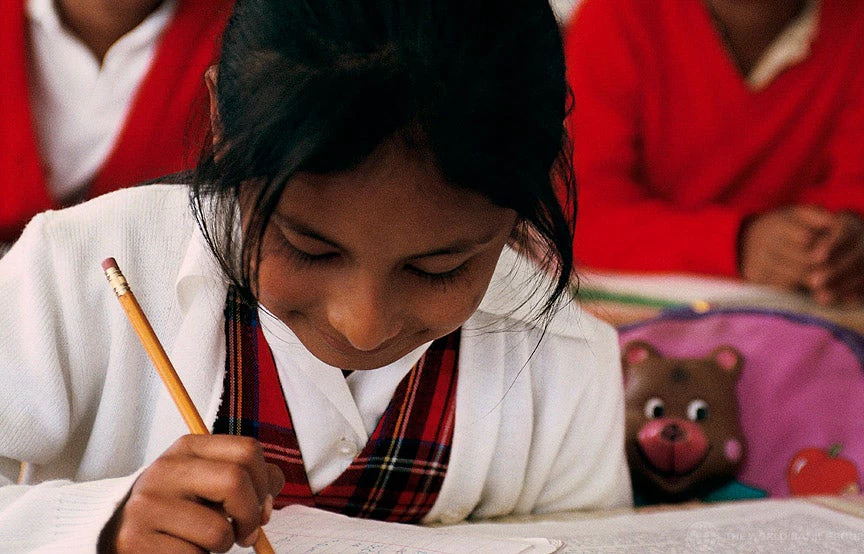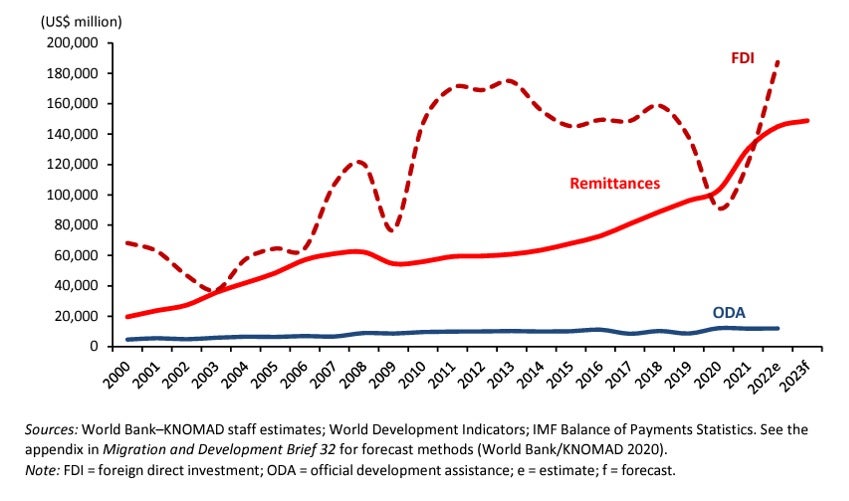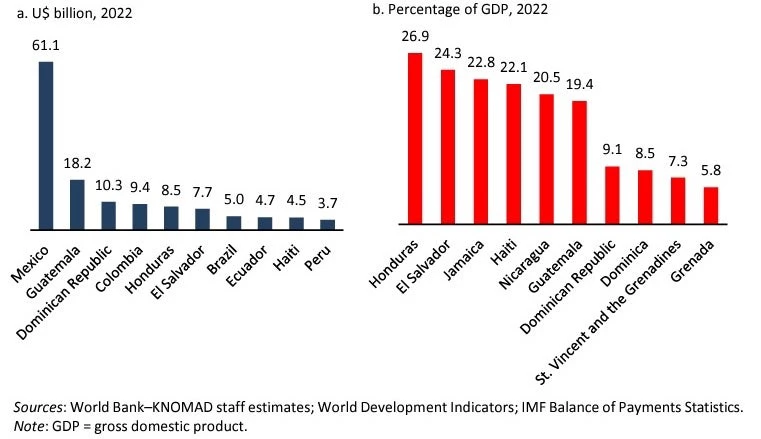 Girl in classroom. Mexico
Girl in classroom. Mexico
After a record increase in remittances in 2021 (26.5 percent), remittance flows into Latin America and the Caribbean increased by 11.3 percent to reach $145 billion in 2022. The strong labor market in the United States had a positive impact on remittance flows during 2022.
Excluding Brazil, where FDI inflows nearly doubled in 2022, remittance flows were significantly larger than FDI flows. Growth in remittances to the region is expected to slow down to 3.3 percent in 2023 and 2.8 percent in 2024.
Remittances, Foreign Direct Investment, and Official Development Assistance Flows to Latin America and the Caribbean, 2000–23f 
Remittances to Mexico reached $61.1 billion in 2022, representing an increase of 12.9 percent. Mexico received the highest level of remittances in the region by far and is the world’s second-largest recipient of remittances. The growth of remittances varied widely across countries in 2022, ranging from a rise of 50 percent in Nicaragua to 18 percent in Guatemala, 17.8 percent in Honduras, and 9.7 percent in Colombia. Remittances to Nicaragua surged by 50 percent during this period, driven by the country’s political situation. However, remittances constitute a much larger share of GDP for a number of countries in the Caribbean and Central America.
Transit migrants from Cuba, Nicaragua, Venezuela and other nationalities passing through Guatemala and Mexico on the way to the United States, account for the large remittance flows to those two transit countries. For example, according to the Bank of Mexico, remittances to Chiapas increased from $250.5 million in Q12020 to $956.6 million in Q12023. This is one of the poorest states in the South where migrants crossing from Guatemala passed through. As noted in Migration and Development Brief 36 (World Bank/KNOMAD 2021a), migrants are staying longer in Mexico which could increase remittances to the country.
Top Remittance Recipients in Latin America and the Caribbean, 2022
The increase in employment in the US sectors where migrants work, such as food and beverage services, health services, and construction, contributed to the growth in remittances to Latin America. According to the US Congressional Budget Office, the number of foreignborn people in the United States from Mexico and Central America was 15.8 million. The share of migrants aged 25 to 54 years old – the group with the highest rate of labor force participation – was greater than the corresponding share of the native-born population5. Recent data released by the Bureau of Labor Statistics reported that foreign-born workers in the labor market increased from 17.4 percent in 2021 to 18.1 percent of the US civilian labor force in 2022 (US Bureau of Labor Statistics 2023). In addition, the unemployment rate of Hispanics declined over three years from 18.5 percent in April 2020 to 4 percent in May 2023 (US Bureau of Labor Statistics 2023).
Remittance corridors from the United States are among the least costly to the Latin American region. According to the Remittance Prices Worldwide database, the costs of sending remittances to Latin America averaged 5.8 percent in 2023Q1. However, costs remained at the same level as since 2015 and much higher in the smaller remittance corridors. For example, the cost of sending money from Canada to Guyana exceeded 10 percent in 2023Q1; from Costa Rica to Nicaragua doubled from 3 percent in 2015Q4 to more than 6 percent in 2023Q1; and from Brazil to Paraguay increased from 6 percent in 2015Q4 to about 8 percent in 2023Q1. The cost of sending money from the United States to Cuba remained high and increased to 21.7 percent in 2022Q4 from a year earlier.
Growth in remittances to the region is projected to slow down to 3.3 and 2.7 percent in 2023 and 2024, with an expected slowdown in the GDP growth for the United States. However, the labor market will hold strong, relative to its condition in previous economic downturns, and unemployment levels will remain stable. Thus, remittances to Latin America will not be severely impacted. Remittances continue growing during the first five months of 2023 in Mexico, Guatemala, El Salvador and Dominican Republic.
Read the latest Migration and Development Brief 38 here.



Join the Conversation